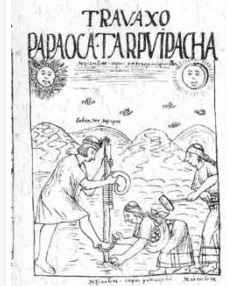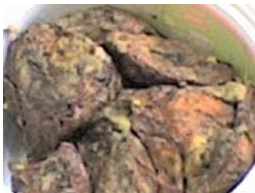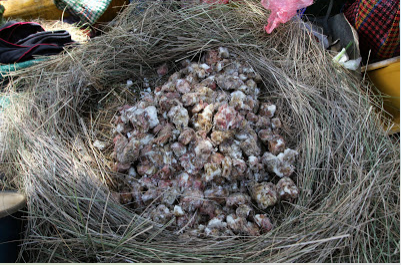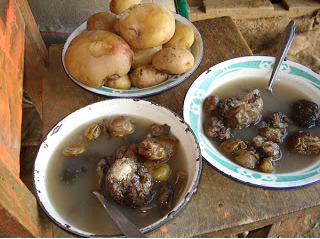It looks like you're using an Ad Blocker.
Please white-list or disable AboveTopSecret.com in your ad-blocking tool.
Thank you.
Some features of ATS will be disabled while you continue to use an ad-blocker.
share:
This one had been a personal research during the last days, soon I found the following information is almost unknown in the world and it must be
shared here. Antibiotics are controlled by health departments/ FDA or similar in most of the countries and if you need it, you are forced to get it
thru a doctor and pay for it. They ignore what I'm about to share here.
IMPORTANT : This thread IS NOT replacing your doctor's recommendations or treatments.

Talking with my wife and her family, seems like they are aware of this ancient knowledge and she recalls her grandfather making this superfood. This knowledge is not lost and it is something any prepper will treasure.
The Tocosh was considered by The Incas a gift of the Apus (gods) and it should be served to show respect and love.

The Tocosh is also known as Tokosh or Togosh is the product made of fermented potatoes, selected after the harvest. The selection of potatoes for Tocosh is also interesting, they use all the bad and bitter potatoes. Here we throw them to the garbage right?
It has a very strong odor due the fermentation as you can imagine and for that reason even in Peru (where it was invented), modern people do not like to use it too much. If you read about its properties, the smell won't matter :
Tocosh Composition :
How to make Tocosh :
The process to make Tocosh is somehow simple and doesn't require any advanced technology, but you need to be patient due the long time it takes. Here are instructions I found in Wikipedia, it seems to be accurate and I'll add some videos if possible, to be sure the process is well understood, no english audio or captions available so pay attention best you can because....you never know.


How to cook Tocosh is also very, very simple. Here a recipe o "Mazzamorra de Tocosh" :
Also, Tocosh is used in soups.

There a few websites that offer Tocosh in flour and capsules imported from Peru, never tried but maybe I will soon. Anyway, I think if you are living in a place like Alaska for example, where you can access to a small river with clean water, you are lucky and have a chance to make your own Tocosh. I would love to know about someone here making Tocosh as a project.
intiaperture.blogspot.com...
es.wikipedia.org...
healthyeatingprogram.wordpress.com...
descubreconsonaly.blogspot.com...
www.recetasdehoy.com...
sites.google.com...
www.inkanatural.com...
IMPORTANT : This thread IS NOT replacing your doctor's recommendations or treatments.

Talking with my wife and her family, seems like they are aware of this ancient knowledge and she recalls her grandfather making this superfood. This knowledge is not lost and it is something any prepper will treasure.
The Tocosh was considered by The Incas a gift of the Apus (gods) and it should be served to show respect and love.

The Tocosh is also known as Tokosh or Togosh is the product made of fermented potatoes, selected after the harvest. The selection of potatoes for Tocosh is also interesting, they use all the bad and bitter potatoes. Here we throw them to the garbage right?
It has a very strong odor due the fermentation as you can imagine and for that reason even in Peru (where it was invented), modern people do not like to use it too much. If you read about its properties, the smell won't matter :
PROPERTY AND TRADITIONAL USE tocosh • Natural Penicillin is a product obtained from fermented potato pulp , a process that activates the antibiotic ( penicillin naturally ) .
• It is antimicrobial.
• Increase the immune system, help us to enjoy good health.
• stomach ulcers : Dilute tocosh spoon flour into a glass of cold water.
• Chronic Gastritis : Dilute tocosh spoon flour into a glass of cold water.
• Kidney problems : Dilute tocosh spoon flour into a glass of cold water
• Hemorrhoids: Dilute tocosh spoon flour into a glass of cold water.
• Prevents osteoporosis.
• Relieves upper respiratory conditions ( bronchitis , pharyngitis, asthma).
• probiotic food.
• Increase the intestinal flora, helping to improve digestion.
• Body Heat: Dilute tocosh spoon flour into a glass of water, sweeten with honey and hot water.
• The flour is used as a healing when someone a wound is healing hemorrhoids .
• inflammation of the prostate.
Tocosh Composition :
High in carbohydrates (80.01g%), protein (3.91g%) with high caloric value of 343.4 cal-g% and low in fat.
How to make Tocosh :
The fermentation process of creating tocosh was discovered by the Incas (or possibly one of the many tribes in their empire). A pool of water with a current is found or dug on the banks of a stream. The potatoes or corn are then placed in a mesh bag of grass, covered with stones, and left undisturbed for six to twelve months. The current flows through the stones to wash away bacteria during fermentation. Once fermentation has occurred, the tocosh is dried in the sun and stored for future use.
The process to make Tocosh is somehow simple and doesn't require any advanced technology, but you need to be patient due the long time it takes. Here are instructions I found in Wikipedia, it seems to be accurate and I'll add some videos if possible, to be sure the process is well understood, no english audio or captions available so pay attention best you can because....you never know.
A hole 1.5 meters deep and 1 meter in diameter is dug in the ground. The bottom and the walls are covered with abundant bunch grass. Then begins to fill the well with potatoes or corn, placing a new layer of bunch grass every 30 inches of potatoes. When the well is already full, covered with a blanket last bunch grass and topped with stones. Finally, through a small ditch the well is filled with water and allowed to run continuously through this well. And thus left for a period ranging from four months to two years. When the stones and bunch grass surface foam with a strong smell of rotten gets up, ready: tocosh called and you can already start collecting. Dried in the sun and it is ready.


How to cook Tocosh is also very, very simple. Here a recipe o "Mazzamorra de Tocosh" :
Ingredients:
1/2 kilo of Tocosh flour,
sugar as desired,
water,
cinnamon, cloves.
Preparation :
Method: Boil the water along with cinnamon, cloves and orange peels, diluted tocosh flour and sugar is added is added, stir constantly until it is ready.
Allow to cool and serve.
Also, Tocosh is used in soups.

There a few websites that offer Tocosh in flour and capsules imported from Peru, never tried but maybe I will soon. Anyway, I think if you are living in a place like Alaska for example, where you can access to a small river with clean water, you are lucky and have a chance to make your own Tocosh. I would love to know about someone here making Tocosh as a project.
intiaperture.blogspot.com...
es.wikipedia.org...
healthyeatingprogram.wordpress.com...
descubreconsonaly.blogspot.com...
www.recetasdehoy.com...
sites.google.com...
www.inkanatural.com...
edit on 7-5-2014 by Trueman because: (no reason given)
Hmm as an herbalist for over 20 years, I thank you for bringing me this, excellent read. My wife and I ferment so many things in many different
methods. We do have a place to follow your procedure in the Appalachians, and we are growing a significant mound of potatoes this year. Thank you, I
will let you know.
originally posted by: BlueJacket
Hmm as an herbalist for over 20 years, I thank you for bringing me this, excellent read. My wife and I ferment so many things in many different methods. We do have a place to follow your procedure in the Appalachians, and we are growing a significant mound of potatoes this year. Thank you, I will let you know.
Thank you so much for taking this information and use it. I guess you'll let me know in about a year the results.
Thanks that's very interesting, I too are very interested in herbal and alternative medicine, in Aotearoa some Maori make a dish or eat what some
call rotten corn, I think it is prepared by put corn on the cob in a flowing stream and leave it for a few months or more, I'm not sure of the time,
then eaten, I'm not sure if they eat it off the cob or then prepare another way,...... Thanks very much
It may say more about me than the subject, but fermenting potatoes makes me think of Vodka more than a medicine.
I guess it Does kill things though.
Haven't even drank anything but beer for about 2 years, but still...(ah get the pun?)
I guess it Does kill things though.
Haven't even drank anything but beer for about 2 years, but still...(ah get the pun?)
edit on 5/7/2014 by Chamberf=6 because: (no reason
given)
originally posted by: Cloudbuster
Thanks that's very interesting, I too are very interested in herbal and alternative medicine, in Aotearoa some Maori make a dish or eat what some call rotten corn, I think it is prepared by put corn on the cob in a flowing stream and leave it for a few months or more, I'm not sure of the time, then eaten, I'm not sure if they eat it off the cob or then prepare another way,...... Thanks very much
Oddly enough, fermented corn also makes me think of alcohol.
It contains sugars, and the potatoes starch===booze.
edit on 5/7/2014 by Chamberf=6 because: two letters
a reply to: Trueman
The bold is added for clarity.
I would suggest that figure is 30cm not 30 inches.
P
A hole 1.5 meters deep and 1 meter in diameter is dug in the ground. The bottom and the walls are covered with abundant bunch grass. Then begins to fill the well with potatoes or corn, placing a new layer of bunch grass every 30 inches of potatoes. When the well is already full, covered with a blanket last bunch grass and topped with stones. Finally, through a small ditch the well is filled with water and allowed to run continuously through this well. And thus left for a period ranging from four months to two years. When the stones and bunch grass surface foam with a strong smell of rotten gets up, ready: tocosh called and you can already start collecting. Dried in the sun and it is ready.
The bold is added for clarity.
I would suggest that figure is 30cm not 30 inches.
P
originally posted by: WanDash
a reply to: Chamberf=6
Is there anything that doesn't make you think of alcohol?
Great thread - OP!
Well most things don't remind me of alcohol...except things fermented to make alcohol.....
I was just kind of saying, yeah they kill things like microbes..............and maybe your liver.
But ok, maybe, just maybe this made me think of something more than beer.
Just ain't gonna go get it.
Just ain't gonna go get it.
originally posted by: BlueMule
Hey thanks bud, looks like a nice addition to my daily smoothie.
From memory the Maori called it "stinky corn" not rotten corn, so I dont know if you would want it in a smoothie.
How much do you take?
Patient: "I am all clogged up and coughing up green phlegm"
Doctor: "take one rotten potato three times daily, come back if it hasn't cleared in a week"
originally posted by: Cloudbuster
Thanks that's very interesting, I too are very interested in herbal and alternative medicine, in Aotearoa some Maori make a dish or eat what some call rotten corn, I think it is prepared by put corn on the cob in a flowing stream and leave it for a few months or more, I'm not sure of the time, then eaten, I'm not sure if they eat it off the cob or then prepare another way,...... Thanks very much
There is also a Corn Tocosh in Peru, unfortunatelly it doesn't have the same properties or stregth as the potatoe Tocosh. Fermented corn had been used even before the Incas, to prepare "Chicha". Delicious alcoholic beverage.
edit on 8-5-2014 by Trueman because: (no reason given)
originally posted by: pheonix358
a reply to: Trueman
A hole 1.5 meters deep and 1 meter in diameter is dug in the ground. The bottom and the walls are covered with abundant bunch grass. Then begins to fill the well with potatoes or corn, placing a new layer of bunch grass every 30 inches of potatoes. When the well is already full, covered with a blanket last bunch grass and topped with stones. Finally, through a small ditch the well is filled with water and allowed to run continuously through this well. And thus left for a period ranging from four months to two years. When the stones and bunch grass surface foam with a strong smell of rotten gets up, ready: tocosh called and you can already start collecting. Dried in the sun and it is ready.
The bold is added for clarity.
I would suggest that figure is 30cm not 30 inches.
P
Thank you, you are right. It has to be centimeters, no inches. Good eye !.
a reply to: Trueman
Very interesting OP!
I'm all for becoming more independent and less reliant on TPTB.
It, again, makes one pause and consider just how much knowledge and know-how has been lost or forgotten.
Ohh to be a time traveler, and just quietly stand in the background, and watch,...
Very interesting OP!
I'm all for becoming more independent and less reliant on TPTB.
It, again, makes one pause and consider just how much knowledge and know-how has been lost or forgotten.
Ohh to be a time traveler, and just quietly stand in the background, and watch,...
originally posted by: pandersway
a reply to: Trueman
It, again, makes one pause and consider just how much knowledge and know-how has been lost or forgotten.
Good reply, specially that part.
Very hard to explain how the Incas or their annexed cultures developed a process to make penicillin, taking in consideration they probably not even knew what it was. Certainly, more than one member might say someone threw on the river a basket of potatoes by accident and 9 months later he was starving, remembered that basket and came back to pick it up and sun-dried the potatoes before eating them. Maybe he didn't throw the basket and he was just a lazy potato washer.
....or maybe someone told the ancient andean people what to do with the bad potatoes of the harvest, skipping scientific explanations of the process. Wonder who can be?
edit on 8-5-2014 by Trueman because: (no reason given)
a reply to: Chamberf=6
I appreciate your thinking, but the method of fermentation, not being enclosed makes me think the alcohol resulting is dispersed in the running water to a great degree. Also, a great many things are created by the resulting good bacteria's "digestion" of the substrate, potato starch. Besides over the course of year, in a fermentation crock for instance, I'd assume a wicked vinegar would result.
The most intriguing thing to me here is the submersion in running water, I'm not sure what bacterial populations are present in a river vs. air. I am no expert, but very, very experienced in fermentation of all kinds of materials and this is just flat out cool. If you were to try to lact0-ferment a potato in a jar, they would explode, they ferment very fast as well, not too mention have you ever smelled a decomposing potato?...OMG it is like the smell of death for weeks...how do I know? I just did it foolishly in one of my compost bins...never again.
Very, very cool...I need a weekend to look somethings up!
I appreciate your thinking, but the method of fermentation, not being enclosed makes me think the alcohol resulting is dispersed in the running water to a great degree. Also, a great many things are created by the resulting good bacteria's "digestion" of the substrate, potato starch. Besides over the course of year, in a fermentation crock for instance, I'd assume a wicked vinegar would result.
The most intriguing thing to me here is the submersion in running water, I'm not sure what bacterial populations are present in a river vs. air. I am no expert, but very, very experienced in fermentation of all kinds of materials and this is just flat out cool. If you were to try to lact0-ferment a potato in a jar, they would explode, they ferment very fast as well, not too mention have you ever smelled a decomposing potato?...OMG it is like the smell of death for weeks...how do I know? I just did it foolishly in one of my compost bins...never again.
Very, very cool...I need a weekend to look somethings up!
a reply to: BlueJacket
Holy cow, yes a rotting or fermenting potato Does smell awful. Yeah, like death as you said.
I had forgotten one lone potato at the bottom of some shelves
(ended up under some bagged rice and dried beans) , man I was almost knocking holes in the walls thinking a raccoon died in the bricks or something.
...And gotta admit I just had stronger things on my mind last night as I was drinking some beers, when talking about the potatoes and corn (or if you mentioned sugar cane....)
That's awesome you're doing composting. It does stink and gets crazy hot but the plants Love it.
Sorry about nearly off-roading your great OP with hard alcohol reminders.
Holy cow, yes a rotting or fermenting potato Does smell awful. Yeah, like death as you said.
I had forgotten one lone potato at the bottom of some shelves
(ended up under some bagged rice and dried beans) , man I was almost knocking holes in the walls thinking a raccoon died in the bricks or something.
...And gotta admit I just had stronger things on my mind last night as I was drinking some beers, when talking about the potatoes and corn (or if you mentioned sugar cane....)
That's awesome you're doing composting. It does stink and gets crazy hot but the plants Love it.
Sorry about nearly off-roading your great OP with hard alcohol reminders.
originally posted by: BlueJacket
a reply to: Chamberf=6
I appreciate your thinking, but the method of fermentation, not being enclosed makes me think the alcohol resulting is dispersed in the running water to a great degree. Also, a great many things are created by the resulting good bacteria's "digestion" of the substrate, potato starch. Besides over the course of year, in a fermentation crock for instance, I'd assume a wicked vinegar would result.
The most intriguing thing to me here is the submersion in running water, I'm not sure what bacterial populations are present in a river vs. air. I am no expert, but very, very experienced in fermentation of all kinds of materials and this is just flat out cool. If you were to try to lact0-ferment a potato in a jar, they would explode, they ferment very fast as well, not too mention have you ever smelled a decomposing potato?...OMG it is like the smell of death for weeks...how do I know? I just did it foolishly in one of my compost bins...never again.
Very, very cool...I need a weekend to look somethings up!
Regarding the water submersion. interesting point. The rivers used to make Tocosh are located in the highlands and the running water is very cold.
Also, to verify the Tocosh is ready they introduce a hand into the water and shake the potatoes gently, if foam comes up to the surface, the Tocosh is ready. That foam probably is the alcohol produced and it will be washed away when the potaoes are pulled out of the water.
edit on 8-5-2014 by Trueman because: (no reason given)
new topics
-
DOJ Special Counsel Robert HUR Says JOE BIDEN Can Be ARRESTED After Jan 20th 2025.
Above Politics: 11 hours ago
top topics
-
DOJ Special Counsel Robert HUR Says JOE BIDEN Can Be ARRESTED After Jan 20th 2025.
Above Politics: 11 hours ago, 9 flags
active topics
-
I thought Trump was the existential threat?
World War Three • 57 • : andy06shake -
Elon Says It’s ‘Likely’ He Buys Tanking MSNBC
Political Ideology • 78 • : CarlLaFong -
DOJ Special Counsel Robert HUR Says JOE BIDEN Can Be ARRESTED After Jan 20th 2025.
Above Politics • 12 • : network dude -
Results of the use of the Oreshnik missile system in Dnepropetrovsk
World War Three • 231 • : andy06shake -
Ok this is some BS now WTH
Rant • 23 • : doctordark -
Anyone like the Scorpions?
Music • 16 • : andy06shake -
Well, here we go red lines crossed Biden gives the go ahead to use long range missiles
World War Three • 368 • : andy06shake -
The Acronym Game .. Pt.4
General Chit Chat • 987 • : JJproductions -
Petition Calling for General Election at 564,016 and rising Fast
Political Issues • 89 • : angelchemuel -
-@TH3WH17ERABB17- -Q- ---TIME TO SHOW THE WORLD--- -Part- --44--
Dissecting Disinformation • 3379 • : brewtiger123
